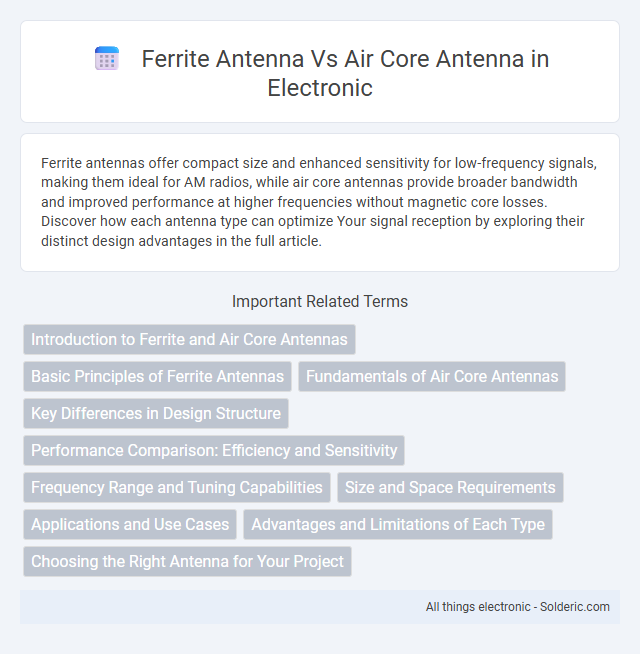Ferrite antennas offer compact size and enhanced sensitivity for low-frequency signals, making them ideal for AM radios, while air core antennas provide broader bandwidth and improved performance at higher frequencies without magnetic core losses. Discover how each antenna type can optimize Your signal reception by exploring their distinct design advantages in the full article.
Comparison Table
| Feature | Ferrite Antenna | Air Core Antenna |
|---|---|---|
| Core Material | Ferrite (magnetic core) | Air (no magnetic core) |
| Size | Compact, small size | Larger physical size |
| Inductance | High inductance due to ferrite core | Lower inductance, requires more turns |
| Signal Range | Better for medium to low frequency (AM band) | Effective for higher frequencies (VHF/UHF) |
| Sensitivity | Higher sensitivity in compact form | Lower sensitivity, depends on size |
| Cost | Generally low cost | Potentially higher cost due to size |
| Use Case | AM radios, compact receivers | FM radios, signal transmission |
| Construction | Coil wound on ferrite rod core | Coil wound on air or non-magnetic form |
Introduction to Ferrite and Air Core Antennas
Ferrite antennas utilize a high-permeability ferrite core to enhance magnetic flux, resulting in improved signal reception and compact size, making them ideal for AM radio applications. Air core antennas, lacking a magnetic core, rely solely on conductor geometry and are preferred for higher frequency applications due to their broader bandwidth and reduced core losses. The choice between ferrite and air core designs depends on frequency range, size constraints, and desired efficiency in radio frequency reception.
Basic Principles of Ferrite Antennas
Ferrite antennas operate based on the principle of using a high-permeability ferrite core to concentrate magnetic flux, significantly enhancing inductance and signal reception sensitivity compared to air core antennas. The ferrite core increases the antenna's effective magnetic area, allowing compact designs suitable for AM radio frequencies and low-frequency applications. Your device's performance in receiving weak electromagnetic signals improves with ferrite antennas due to their ability to efficiently capture and convert magnetic fields into electrical signals.
Fundamentals of Air Core Antennas
Air core antennas operate without a ferromagnetic core, utilizing only the air as the magnetic medium, which minimizes core losses and enables higher-frequency operation. Their inductance primarily depends on coil geometry, such as the number of turns and coil diameter, allowing for predictable and stable inductive properties. Commonly used in RF applications where low core loss and high Q-factor are critical, air core antennas excel in transmitting and receiving signals with minimal distortion.
Key Differences in Design Structure
Ferrite antennas utilize a core made of ferrite material that increases inductance and magnetic field concentration, resulting in a compact design suitable for AM radio reception. Air core antennas lack a magnetic core, relying solely on the coil of wire for inductance, which leads to larger size but improved high-frequency response and reduced core losses. Your choice between ferrite and air core antennas depends on the need for size efficiency versus frequency performance.
Performance Comparison: Efficiency and Sensitivity
Ferrite antennas exhibit higher sensitivity and better signal reception in low-frequency ranges due to their magnetic core, which concentrates magnetic flux and improves efficiency in compact sizes. Air core antennas, lacking a magnetic core, have lower efficiency but offer broader bandwidth and reduced signal distortion, making them suitable for high-frequency applications. Your choice depends on whether sensitivity in tight spaces or wide frequency response is the priority for your antenna performance needs.
Frequency Range and Tuning Capabilities
Ferrite antennas excel in low to medium frequency ranges, typically up to a few MHz, providing strong inductance and compact size ideal for AM radio and low-frequency applications. Air core antennas cover a broader frequency spectrum, from VHF to UHF, offering wideband performance with minimal core losses and easier tuning across higher frequencies. Your choice depends on required frequency range and tuning precision, with ferrite antennas favored for narrowband low-frequency circuits and air core antennas preferred for flexible, higher-frequency tuning.
Size and Space Requirements
Ferrite antennas are compact and ideal for applications with limited space due to their magnetic core, which allows efficient signal reception in a small form factor. Air core antennas are generally larger because they lack a magnetic core, requiring more physical space to achieve similar inductance and sensitivity levels. Choosing a ferrite antenna can optimize Your device's size constraints while maintaining performance in tight installations.
Applications and Use Cases
Ferrite antennas are widely used in AM radio receivers and low-frequency communication devices due to their compact size and high magnetic permeability, enhancing signal reception in confined spaces. Air core antennas are preferred in high-frequency and VHF/UHF applications like television broadcasting and radar systems because they offer low loss and wide bandwidth. Industrial RFID systems and wireless communication networks leverage air core antennas for efficient signal transmission over longer distances.
Advantages and Limitations of Each Type
Ferrite antennas offer compact size and enhanced sensitivity at lower frequencies due to their high magnetic permeability, making them ideal for AM radio receivers, but they suffer from limited bandwidth and saturation issues under strong signals. Air core antennas provide broader frequency response and higher power handling capabilities without magnetic losses, suitable for VHF and UHF applications, yet they are larger and less sensitive at lower frequencies. Choosing between ferrite and air core antennas depends on the specific frequency range, size constraints, and performance requirements of the application.
Choosing the Right Antenna for Your Project
Ferrite antennas offer compact size and high sensitivity, making them ideal for AM radio reception and low-frequency applications where space is limited. Air core antennas provide broader bandwidth and lower signal distortion, suited for high-frequency and wideband projects requiring minimal inductive losses. Selecting the right antenna depends on factors such as frequency range, physical constraints, and desired signal fidelity in your specific application.
ferrite antenna vs air core antenna Infographic

 solderic.com
solderic.com